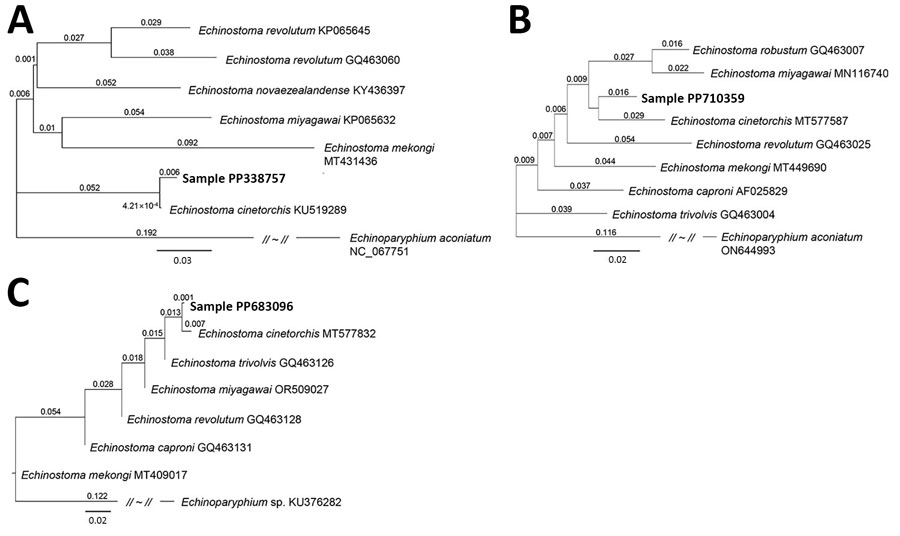Rare Case of Echinostoma cinetorchis Infection, South Korea
Sooji Hong, Hyejoo Shin, Yoon-Hee Lee, Sung-Jong Hong, So-Ri Kim, Youn-Kyoung Kim, Young-Jin Son, Jeong-Gil Song, Jong-Yil Chai, and Bong-Kwang Jung

Author affiliations: MediCheck Research Institute, Korea Association of Health Promotion, Seoul, South Korea (S. Hong, H. Shin, Y.-H. Lee, J.-Y. Chai, B.-K. Jung); Convergence Research Center for Insect Vectors, Incheon National University, Incheon, South Korea (S.-J. Hong); Dr. Song Jeong-Gil’s Internal Medical Clinic, Pyeongtaek, South Korea (S.-R. Kim, Y.-K. Kim, Y.-J. Son, J.-G. Song); Seoul National University College of Medicine, Seoul (J.-Y. Chai)
Main Article
Figure 2

Figure 2. Phylogenetic trees of a worm identified as Echinostoma cinetorchis removed during colonoscopy from a 69-year-old woman in South Korea (bold text). Trees were based on nucleotide sequences of the NADH dehydrogenase 1 gene (A), cytochrome c oxidase subunit 1 mitochondrial gene (B), and internal transcribed spacer region (C) of the worm in comparison with various echinostome species deposited in GenBank (accession numbers shown), inferred by the neighbor-joining method (1,000 bootstrap replications) using the Geneious Prime Program 2023.1.2. (Geneious, https://www.geneious.com). Echinoparyphium aconiatum (NADH dehydrogenase 1 and cytochrome c oxidase subunit 1 mitochondrial genes) and Echinoparyphium sp. (internal transcribed spacer) were used as the outgroups. Scale bars indicate evolutionary distance.
Main Article
Page created: June 28, 2024
Page updated: July 22, 2024
Page reviewed: July 22, 2024
The conclusions, findings, and opinions expressed by authors contributing to this journal do not necessarily reflect the official position of the U.S. Department of Health and Human Services, the Public Health Service, the Centers for Disease Control and Prevention, or the authors' affiliated institutions. Use of trade names is for identification only and does not imply endorsement by any of the groups named above.
